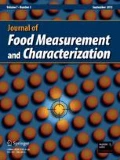Abstract
Biscuits with a high digestive fibre content constitute one of the growing sectors in the European food industry due to the consumer’s positive perception of nutritional qualities of fibre often uncommon in the average diet. Texture, being one of the major sensorial parameters in the quality perception of biscuits and that after opening the packaging the high fibre content of digestive-type biscuits captures ambient humidity quickly; thus this product is very susceptible to changes in texture, which could be disagreeable for the consumer. The aim of this study was to optimise the test settings of two different texturometric techniques (Vertical puncture and Three-point bending) and determine which one would be better as a quality assurance technique, characterising the texture of the digestive-type biscuits during the self-life. Therefore four commercial brands of digestive-type biscuits, usually sold on the Spanish market, were stored at room temperature for 4 months and analysed monthly. It was observed how increasing moisture values modify the texture of the biscuits and which technique and analysis settings keep measurements more precise. It was noted that puncture technique, applying a test speed of 3.75 mm/s with a cylindrical P/2 probe, within the central and intermediate area of the biscuits was the most accurate method to determine and compare the evolution of the texture of each brand and between different commercial brands of biscuit, respectively.

Similar content being viewed by others
References
M. Bes-Rastrollo, M.A. Martínez-González, A. Sánchez-Villegas, C. De la Fuente Arrillaga, Orig. Nutr. 22, 504–511 (2006). doi:10.1016/j.nut.2005.12.006
M. Garaulet, F. Pérez-Llamas, C.M. Rueda, S. Zamora, Nutr. Res. 18(6), 979–988 (1998). doi:10.1016/S0271-5317(98)00081-5
P. Farajian, A. Zampelas, Chapter 7—Mediterranean diet in children and adolescents. in The Mediterranean Diet, ed. by V.R. Preedy, R.R. Watson (Academic Press, Cambridge, 2015), pp. 69–85. doi:10.1016/B978-0-12-407849-9.00007-5
J.L. Hazelton, J.L. DesRochers, C.E. Walker, Cookies, biscuits, and crackers. Chemistry of manufacture. in Encyclopedia of Grain Science ed. by C. Wrigley (Academic Press, Cambridge, 2004), p. 533. doi: 10.1016/b0-12-765490-9/00208-1
M.C. Bourne, Food Texture and Viscosity: Concept and Measurement. (Academic Press Inc., New York, 1982)
Q. Saleem, R.D. Wildma, J.M. Huntley, M.B. Whitwort, J. Food Eng. 68(1), 19–32 (2005). doi:10.1016/j.jfoodeng.2004.05.020
I.G. Mandala, C.A. Ioannou, A.E. Kostaropoulos, Int. J. Food Sci. Technol. 41(7), 782–789 (2006). doi:10.1111/j.1365-2621.2005.01092.x
S.K. Tyagi, M.R. Manikantan, H. Singh Oberoi, G. Kaur, J. Food Eng. 80(4), 1043–1050 (2007). doi:10.1016/j.jfoodeng.2006.08.016
D.P. Singh, S. Ahmad, P.K. Srivastava, A.K. Srivastava, Beverage Food World 32(9), 27–31 (2005)
B. Singh, M. Bajaj, A. Kaur, S. Sharma, S. Sindhu, Plant Foods Hum. Nutr. 43(2), 181–189 (1993). doi:10.1007/BF01087922
M. Kaur, K.S. Sandhu, A.P. Arora, A. Sharma, LWT-Food Sci. Technol. 62(1 Part 2), 628–632 (2015). doi:10.1016/j.lwt.2014.02.039
C.S. Gaines, A. Kassuba, P.L. Finney, J.R. Donelson, Instrumental measurement of cookie harness. II. Application to product quality variables. Cereal Chem. 69(2), 120–125 (1994). http://www.aaccnet.org/publications/cc/backissues/1992/Documents/69_125.pdf
L.M.L. Nollet, Handbook of Food Analysis, 3rd edn. (Marcel Dekker, New York, 1996)
B. James, A. Young, B. Smith, E. Kim, A. Wilson, M.P. Morgenstern, Proc. Food Sci. 1, 632–639 (2011). doi:10.1016/j.profoo.2011.09.095
F.J. Rojo, J.F.V. Vincent, Eng. Fail. Anal. 16(8), 2698–2704 (2009). doi:10.1016/j.engfailanal.2009.04.033
G.L. Robertson, Chapter 20—Packaging materials for biscuits and their influence on shelf life. in Manley’s Technology of Biscuits, Crackers and Cookies ed. by D. Manley, 4th edn (Elsevier, Amsterdam, 2011), pp. 247–267
D. Manley, H. Clark, Chapter 42—Biscuit packaging and storage. in Manley’s Technology of Biscuits, Crackers and Cookies ed. by D. Manley, 4th edn (Elsevier, Amsterdam, 2011), pp. 547–563
L. Chena, U.L. Opara, Food Res. Int. 51(2), 823–835 (2013). doi:10.1016/j.foodres.2013.01.046
D.J. Burt, T.D. Fearn, J. Starch 35(10), 351–354 (1983). doi:10.1002/star.19830351005
S.S. Ahmad, M.T. Morgan, M.R. Okos, J. Food Eng. 50(2), 63–75 (2001). doi:10.1016/S0260-8774(00)00186-2
H. Faridi, The Science of Cookie and Cracker Production (Chapman and Hall, London, 1994), pp. 455–495
B. Filipčev, O. Šimurina, M. Sakač, I. Sedej, P. Jovanov, M. Pestorić, M. Bodroža-Solarov, Food Chem. 125(1), 164–170 (2011). doi:10.1016/j.foodchem.2015.08.055
H. Mamat, M.O. Abu Hardan, S.E. Hill, Food Chem. 121(4), 1029–1038 (2010). doi:10.1016/j.foodchem.2015.01.043
E. Lara, P. Cortés, V. Briones, M. Perez, LWT-Food Sci. Technol. 44(3), 622–630 (2011). doi:10.1016/j.lwt.2015.15.007
Acknowledgements
The authors thank The Agency of Economic Development of La Rioja (ADER La Rioja), for its financial support for the realisation of this work. (Alcabiscuit-28-I-ID00181).
Author information
Authors and Affiliations
Corresponding author
Rights and permissions
About this article
Cite this article
San José, F., Collado-Fernández, M. & López, R. Texturometric determination of digestive biscuits. Food Measure 12, 412–425 (2018). https://doi.org/10.1007/s11694-017-9654-7
Received:
Accepted:
Published:
Issue Date:
DOI: https://doi.org/10.1007/s11694-017-9654-7




